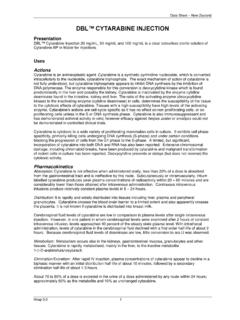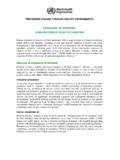Transcription of Guidelines for vaccination of ... - ecil-leukaemia.com
1 Guidelines for vaccination of patients with hematological malignancies and hsct recipients Final version Sept. 23, 2017 ECIL 7 Vaccine Group Members Catherine Cordonnier (France) Simone Cesaro (Italy) Hugues De Lavallade (UK) Roberta Di Blasi (Italy) Sigrun Einarsdottir (Sweden) Dan Engelhard (Israel) Giuseppe Gallo (Italy) Per Ljungman (Sweden) Malgorzata Mikulska (Italy) Christina Rieger (Germany) ECIL 7 meeting Juan-les-Pins, France Sept. 21-23, 2017 INTRODUCTION Common issues to vaccination in hematology patients (1/2) An area often neglected by hematologists Few or no data with some vaccines Number of patients needed to show a clinical efficacy of vaccines in rare diseases: impossible to reach Efficacy mostly defined on biological parameters whose protective effect was established in healthy individuals.
2 Clinical pertinence of such parameters unknown in immunocompromised pts Many hematological diseases = many different types of immunodeficiencies: difficult to transfer data from one population to another Treatments of hematological diseases fastly evolve Common issues to vaccination in hematology patients (2/2) Lower vaccine response than healthy people of the same age range Few or no data on the durability of the response Live attenuated vaccines (LAV) contra-indicated, with some exceptions Timing is crucial Main reasons to vaccinate hematology patients Higher risk than healthy individuals of the same age to acquire community infections (eg.)
3 Pneumococcal disease, Flu) Higher risk of infection-related hospitalization, respiratory failure, ICU stay, and death for most vaccine-preventable infections Risk that the infection delays or precludes the treatment of the underlying disease Decreased herd immunity in countries where vaccination is not mandatory Many infections observed in hematology patients are vaccine-preventable Vaccines may preclude - or at least decrease the severity of - the disease Two different goals of vaccination in hematology patients To protect the patient against specific infections whose risk is clearly increased by the disease and/or the treatment procedures when compared to the healthy
4 Individuals eg. S pneumoniae and hsct , Influenza infection To offer him/her, as soon as possible, the same protection as healthy individuals for vaccines recommended in their country: individual and community benefit ECIL 7 Guidelines For non-transplanted hematology patients (Part I): - by underlying disease For hsct patients (Part II): - by type of vaccine Outside the scope of this review: primary immune deficiencies, splenectomy, non-malignant hematological diseases Grading system (According to ESCMID) ECIL Roadmap hsct Catherine Per Sigrun Allo Auto Non- hsct Hugues, Roberta AML, MDS, Chronic myeloproliferative disorders (CMD) Malgorzata, Giuseppe Lymphoproliferative diseases (LPD): myeloma, lymphoma, CLL Pediatric specificities: Simone, Dan Side effects Christina, Dan Live vaccines Simone, Giuseppe Children ALL Part I: vaccination of non-transplanted patients with hematological malignancies - I A: Myeloid diseases - I B.
5 Lymphoproliferative diseases - I C: Children Acute lymphoblastic leukemia (ALL) Part II: vaccination in hsct recipients Part I A: vaccination in patients with myeloid diseases Acute myeloid leukaemia (AML) and myelodysplastic syndrome (MDS) Chronic myeloid leukaemia (CML) Myeloproliferative disorders (MPDs) vaccination data in myeloid diseases Important aspects: The effect of treatment is determinant on vaccine efficacy: Standard intensive chemotherapy Tyrosine Kinase Inhibitors (TKI) (CML) JAK inhibitors (MPDs) Little data on vaccination in these groups of patients Available influenza vaccines Inactivated (IIV), usually trivalent (Trivalent inactivated vaccine.)
6 TIV), but possibly also quadrivalent (evaluable from the 2014-2015 season in some EU/EEA countries) or monovalent ( against 2009 H1N1 pandemic strain), containing The whole virus Non adjuvanted (Intramuscular, Intradermal) Adjuvanted ( with squalene, MF59, or AS03 - squalene and -tocopherol, or aluminium phosphate gel) Cell-based influenza vaccines which can be given to egg-allergic individuals (not available in all EU/EEA countries) Split-influenza virus products Subunit influenza products Live attenuated quadrivalent influenza vaccine (LAIV) for intranasal use, approved in the EU/EEA for children and adolescents (2-17 years of age) in 2011 (Fluenz tetra ).
7 THE LAIV is contra-indicated in hsct recipients (safety issue, no data in hsct , and IIV alternatives exist) All data presented in the next slides only concern IIVs vaccination data in adult patients with MDS No published data Median age of MDS patients is 75 years and as such, they should receive vaccination against influenza and pneumococcus However disease heterogeneity should be taken into account: for instance infections in CMML > RCMD (Refractory Cytopenia with Multilineage Dysplasia) Influenza Slightly increased incidence of influenza in comparison to the general population HBV Acute HBV hepatitis has been associated with delays in chemotherapy In low HBV prevalence setting, there is very low risk of de novo HBV infection due to safe blood products Risk of de novo HBV infection exists in some high HBV prevalence countries due to high rates of horizontal transmission (blood transfusions, interventional procedures, etc.)
8 Other No sufficient data for VZV, MMR, DTP, meningococcus and pneumococcus in adults vaccination in AML Ljungman et al. BJH 2005; Cherif et al. Eur J Haematol, 2013; Spickermann et al. Leukemia and Lymphoma 1994; Titmarsh et al. Cancer Epidemiology 2014; Metafuni et al, MJHID, 2017; Pullucku et al. Int J of Inf Dis, 2008; Mallet, ECIL-5 Guidelines , Lancet Infect Dis 2016 Loss of previous immunity is less pronounced in AML than in ALL children (in line with adult setting, tetanus) However, if revaccinated, both groups mount a satisfactory response once treatment is finished Extrapolation to adult population: revaccination of selected adult AML patients after completion of chemotherapy might be successful and may have clinical benefit, for example given low residual immunity to tetanus following AML chemotherapy Other vaccination data in AML.
9 Paediatric population, summary and impact on adult AML patients Hammarstrom et al. Support Cancer Care 1998; Bochennek et al., Vaccine 2014; Patel et al. CID 2007; Cheng et al. Arch Dis Child 2012; Patel et al. Arch Dis Child 2012; Spickermann et al. Leukemia and Lymphoma 1994 Chronic myeloid diseases CML patients in pre TKI era had an increased risk of respiratory and skin infections (Titmarsh 2014) TKIs further increase this risk, but precise data not available Risk of reactivations of hepatitis B with TKIs have been repeatedly reported leading to a recommendation of the EMA to screen all patients for HBV before starting TKI Case reports on dasatinib-induced opportunistic infection (Chang, IJID 2014)
10 TKI treatment might lower the vaccine efficacy Response to pneumococcal vaccination was lower than in healthy controls Reponses to influenza vaccination (inactivated and adjuvanted) was similar to healthy controls Titmarsh et al. Cancer Epidemiology 2014; Rubin et al. CID 2013; Chang et al. Int J Infect Dis. 2014; de Lavallade et al. Blood 2013; de Lavallade et al. Haematologica 2011 Infection incidence in CML patients on Tyrosine Kinase Inhibitors (TKI) Myeloproliferative disorders (MPD) and ruxolitinib Data suggest no increased risk of infection in patients with MPDs in the pre-JAKi era Ruxolitinib is associated with an increased risk of infections, and in particular HZ and opportunistic infections JAKi treatment might lower the vaccine efficacy No data on the efficacy of vaccination in patients on JAKi ECIL 7 Guidelines on vaccination Myeloid diseases.







